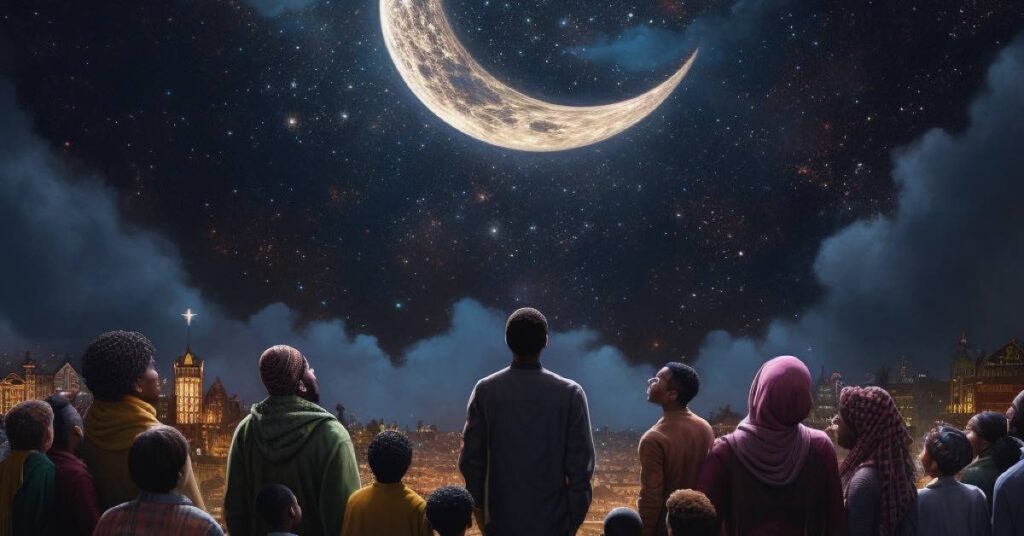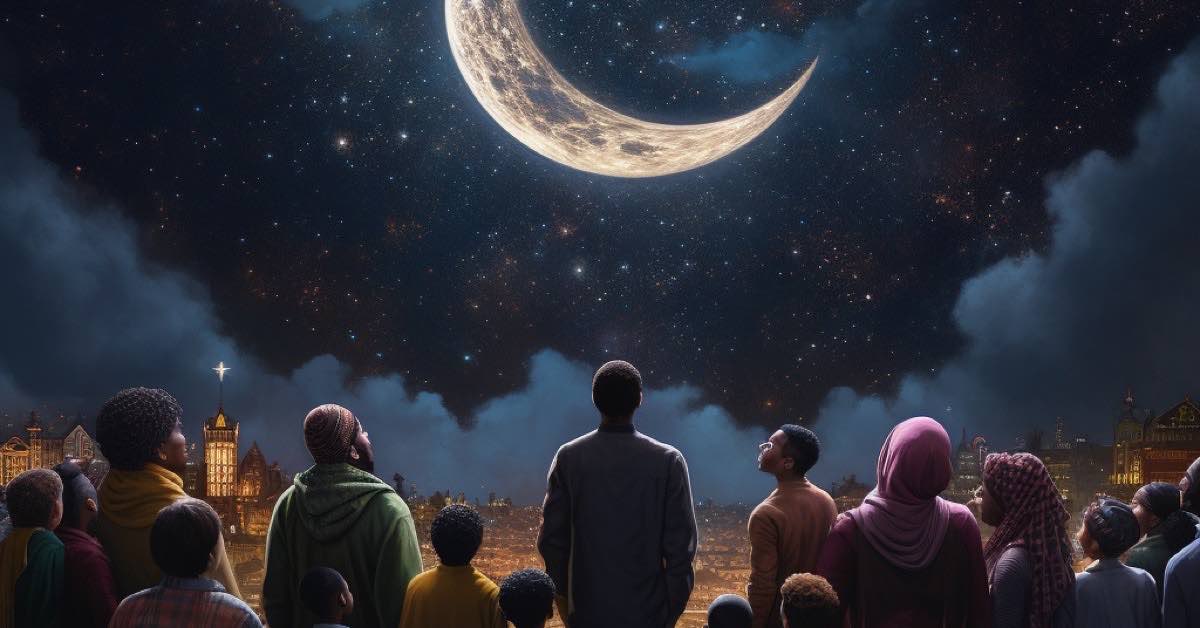Throughout human history, celestial bodies have captured our awe and imagination. From the blazing sun to the shimmering stars, these celestial objects have inspired myths, legends, and symbolisms across countless cultures.
Perhaps one of the most universally recognized symbols is the crescent moon. Its alluring shape and gentle glow have intrigued humanity for centuries, leading to diverse interpretations across different belief systems.
The centrality of celestial symbolism in human culture stems from a deep-seated fascination with elements beyond our reach – those mysterious entities that seemingly control the ebb and flow of life on Earth. The moon’s prominence amidst this grand cosmic tapestry has made it an object of veneration in various societies throughout time.

While its fully illuminated form evokes awe during full moons or harvest festivals, what captivates us further is the delicate curve seen during its transition phases – culminating in shapes reminiscent of a slender arc or a serene crescent.
The significance attributed to this slender lunar shape is truly remarkable; it encompasses both spiritual and cultural dimensions that stretch across continents and millennia.
In this article, we will unveil captivating insights into how cultures from ancient civilizations to modern times perceive and interpret the symbolic meaning behind the humble yet enigmatic crescent moon. Prepare yourself for a journey through time as we explore how various civilizations assigned unique importance to this radiant emblem emblazoned upon our night skies.
Crescent Moon Symbolism in Ancient Civilizations
Mesopotamia
In ancient Mesopotamia, the crescent moon played a significant role in their mythologies and religious beliefs. Lunar deities such as Nanna Sin were associated with the moon’s cycles and believed to govern life, death, and fertility.
The crescent shape represented continuity and renewal, reflecting the cyclical nature of time. Additionally, cults dedicated to fertility goddesses like Ishtar saw the crescent moon as a symbol of feminine power and beauty.
Egypt
Ancient Egyptian civilization also attributed great symbolism to the crescent moon. It appeared on various artifacts throughout their history, often associated with depictions of gods and goddesses.
One prominent connection was made between the crescent moon symbol and Isis, a powerful goddess linked to femininity, motherhood, healing, magic, regeneration and rebirth. The waxing crescent phase represented growth while the waning phase symbolized decay or death.
Greece & Rome
In Greek mythology, Artemis (known as Diana in Roman mythology), sister of Apollo and daughter of Zeus was closely related to the image of the crescent moon.
She was commonly depicted wearing a delicate crown adorned with horns similar to that of a lunar shape – emphasizing her association with celestial bodies. This imagery served not only as an emblem of her divine authority but also embodied themes such as changeability
Religious & Spiritual Interpretations Worldwide
Islam
The crescent moon holds great significance within the Islamic faith, symbolizing rebirth or renewal. It is often associated with the beginning of a new lunar month and marks important events like Eid al-Fitr and Eid al-Adha.
The sighting of the crescent moon also plays a crucial role in determining dates for Islamic festivals and rituals. Moreover, as this celestial symbol waxes and wanes, it serves as a reminder of life’s cyclical nature and the constant ebb and flow of time.
Hinduism
In Hinduism, the crescent moon is closely linked to various deities such as Shiva or Parvati. For instance, Lord Shiva wears a crescent moon on his head, which represents enlightenment. This lunar adornment signifies wisdom gained through introspection and meditation.
Additionally, Parvati is often depicted wearing a crescent-shaped ornament known as chandra kanta in her hair, indicating her association with feminine energy and mystical powers.
Wicca Paganism
Within Wicca Paganism beliefs revolve around embracing cycles of transformation through lunar associations – particularly for goddess worship – seeing themselves reflected in her changing phases brings adherents closer to nature’s rhythms.
They believe that during certain phases like new moons or waxing crescents, there are opportunities for growth while full-moon energies can be harnessed for manifestation or spellwork purposes.
These examples highlight just a few interpretations across multiple cultures that emphasize how much symbolism humans have attributed to the humble image of the crescent moon over centuries — representing anything from renewal and enlightenment to exploring personal transformative power aligning themselves within larger cosmic forces at work
Astrological Significance of the Crescent Moon
New Moon vs. Waxing Crescent: Different interpretations within astrology
In astrology, the celestial body that governs our emotions and instincts is the moon. When it comes to the crescent moon, its significance varies depending on its specific phase. The new moon, for instance, represents a time of renewal and new beginnings. It symbolizes planting seeds for future projects or manifestations in one’s life.
On the other hand, the waxing crescent moon offers a different interpretation. As it begins to grow in size after the darkness of a new moon, this phase signifies progress and forward momentum. It embodies optimism, positive energy, and potentiality as individuals work towards manifesting their desires.
Influence on personality, emotions, and transformation
The crescent moon’s symbolism extends beyond just astrological interpretation; it also carries implications for individual personalities and emotional growth. Those who resonate strongly with this symbol are often seen as intuitive beings with heightened psychic abilities.
Furthermore, the transformative power associated with the waxing crescent suggests personal growth and evolution. Just as the sliver of light increases day by day until it eventually becomes a full-fledged luminous orb, individuals who align themselves with this stage may experience profound personal transformations over time.
Their journey might involve shedding old patterns or identities they have outgrown to make way for new possibilities.
Understanding these different interpretations within astrology sheds light on how diverse cultures view and interpret this celestial phenomenon: from its connection to fresh starts during new moons to its association with progression during waxing phases; there is no shortage of symbolic meaning attached to the gentle curve adorning our night skies
Contemporary Usage & Popular Culture: Incorporation of crescent moon symbolism in modern fashion, art, and jewellery
In addition to its ancient significance, the crescent moon symbol continues to captivate and inspire in modern times. It has found a place not only in cultural practices but also in popular culture, making appearances in various forms of artistic expression. From fashion runways to tattoo parlours, the crescent moon has secured itself as a beloved motif.
One notable platform where the crescent moon thrives is within fashion. Designers have embraced this timeless symbol by incorporating it into their collections. Whether gracing delicate necklaces or embellished garments with shimmering sequins or embroidery, the allure of the celestial body remains irresistible.
Celebrities often flaunt iconic looks featuring this lunar emblem on red carpets and magazine covers alike. Its mystical charm adds a touch of elegance and mystique that transcends trends.
Moreover, artists find inspiration from the symbolic power embedded within the crescent moon. Paintings and sculptures frequently feature depictions of moonscapes illuminated by their gentle radiance—a nod to our connection with nature’s cycles and rhythms.
Surrealists like Salvador Dalí utilized its imagery as a metaphor for dreams and spirituality while street artists use spray paint cans to leave behind colourful murals showcasing vast moonscapes against urban backdrops—an extraordinary fusion between tradition and contemporary artistry.
The versatility of the crescent moon extends beyond traditional mediums into other forms such as tattoos—permanent symbols etched onto skin embodying personal meanings for those who bear them proudly. The image can be seen adorning bodies both subtly and prominently depending on individual tastes.
Incorporating cultural motifs into creative endeavours allows us to explore historical roots while connecting them with today’s global society—it is through these intentional crossovers that we embrace multicultural experiences universally
Main Points
Throughout history, the crescent moon has held immense symbolic meaning across various cultures. In ancient Mesopotamia, it was associated with the lunar deity Sin and represented fertility and abundance.
The Islamic faith adopted the symbol as a representation of their religion, featuring prominently on mosques and flags. In pagan traditions, the waxing and waning cycles of the crescent moon were connected to feminine energy and renewal.
Furthermore, in Hindu mythology, Lord Shiva is often depicted wearing a crescent moon in his hair, signifying enlightenment. In Chinese culture, the yin-yang symbol incorporates a crescent shape to represent a balance between opposing forces.
And let us not forget that numerous civilizations have correlated celestial bodies like planets and moons to omens for prophecy or seasonal changes.
Highlighting Ongoing Universal Fascination with Crescent Moon Symbolism
The fascination surrounding the symbolism of the crescent moon continues to captivate individuals worldwide today. It remains adored as an emblematic motif in various domains such as jewellery design, tattoo artistry, home décor accessories, and fashion trends. The universal appeal lies in its rich cultural significance transcending time, serving multiple interpretations among different belief systems.
Additionally, the modern usage of this enchanting celestial emblem has expanded beyond religious associations; it has become a general symbol representing mysticism, new beginnings, femininity, magic, and intuition. Presently, various popular consumer brands incorporate this iconography into their logos, tapping into its enduring allure.
Moreover, it continues to be embraced by contemporary artists with increased global popularity, and continuing demand for products bearing such motifs. Considered timeless, this phrasal figure never loses appeal due to its inherent celestial magic combined with deep-rooted historical connections seen around our world!
